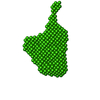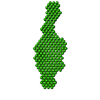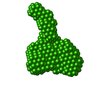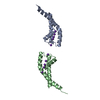[English] 日本語
 Yorodumi
Yorodumi- SASDF27: Brain and Muscle ARNT-Like 1 from Mus musculus (D530-L625), monom... -
+ Open data
Open data
- Basic information
Basic information
| Entry | Database: SASBDB / ID: SASDF27 |
|---|---|
 Sample Sample | Brain and Muscle ARNT-Like 1 from Mus musculus (D530-L625), monomer, trans-conformation locking mutation P624A
|
| Function / homology | Isoform 2 of Basic helix-loop-helix ARNT-like protein 1 Function and homology information Function and homology information |
| Biological species |  |
 Citation Citation |  Journal: J Biol Chem / Year: 2019 Journal: J Biol Chem / Year: 2019Title: Structural and mechanistic insights into the interaction of the circadian transcription factor BMAL1 with the KIX domain of the CREB-binding protein. Authors: Archit Garg / Roberto Orru / Weixiang Ye / Ute Distler / Jeremy E Chojnacki / Maja Köhn / Stefan Tenzer / Carsten Sönnichsen / Eva Wolf /  Abstract: The mammalian CLOCK:BMAL1 transcription factor complex and its coactivators CREB-binding protein (CBP)/p300 and mixed-lineage leukemia 1 (MLL1) critically regulate circadian transcription and ...The mammalian CLOCK:BMAL1 transcription factor complex and its coactivators CREB-binding protein (CBP)/p300 and mixed-lineage leukemia 1 (MLL1) critically regulate circadian transcription and chromatin modification. Circadian oscillations are regulated by interactions of BMAL1's C-terminal transactivation domain (TAD) with the KIX domain of CBP/p300 (activating) and with the clock protein CRY1 (repressing) as well as by the BMAL1 G-region preceding the TAD. Circadian acetylation of Lys within the G-region enhances repressive BMAL1-TAD-CRY1 interactions. Here, we characterized the interaction of the CBP-KIX domain with BMAL1 proteins, including the BMAL1-TAD, parts of the G-region, and Lys Tethering the small compound 1-10 in the MLL-binding pocket of the CBP-KIX domain weakened BMAL1 binding, and MLL1-bound KIX did not form a ternary complex with BMAL1, indicating that the MLL-binding pocket is important for KIX-BMAL1 interactions. Small-angle X-ray scattering (SAXS) models of BMAL1 and BMAL1:KIX complexes revealed that the N-terminal BMAL1 G-region including Lys forms elongated extensions emerging from the bulkier BMAL1-TAD:KIX core complex. Fitting high-resolution KIX domain structures into the SAXS-derived envelopes suggested that the G-region emerges near the MLL-binding pocket, further supporting a role of this pocket in BMAL1 binding. Additionally, mutations in the second CREB-pKID/c-Myb-binding pocket of the KIX domain moderately impacted BMAL1 binding. The BMAL1(K537Q) mutation mimicking Lys acetylation, however, did not affect the KIX-binding affinity, in contrast to its enhancing effect on CRY1 binding. Our results significantly advance the mechanistic understanding of the protein interaction networks controlling CLOCK:BMAL1- and CBP-dependent gene regulation in the mammalian circadian clock. |
 Contact author Contact author |
|
- Structure visualization
Structure visualization
| Structure viewer | Molecule:  Molmil Molmil Jmol/JSmol Jmol/JSmol |
|---|
- Downloads & links
Downloads & links
-Models
| Model #3049 |  Type: dummy / Radius of dummy atoms: 2.50 A / Chi-square value: 1.139 / P-value: 0.983057  Search similar-shape structures of this assembly by Omokage search (details) Search similar-shape structures of this assembly by Omokage search (details) |
|---|
- Sample
Sample
 Sample Sample | Name: Brain and Muscle ARNT-Like 1 from Mus musculus (D530-L625), monomer, trans-conformation locking mutation P624A Specimen concentration: 3.27 mg/ml |
|---|---|
| Buffer | Name: 25 mM Hepes, 150 NaCl, 1 mM DTT, 5% Glycerol / pH: 7.2 |
| Entity #1676 | Name: BMAL1 P624A / Type: protein Description: Aryl hydrocarbon receptor nuclear translocator-like protein 1 Formula weight: 9.853 / Num. of mol.: 1 / Source: Mus musculus / References: UniProt: Q9WTL8-2 Sequence: GPDASSPGGK KILNGGTPDI PSTGLLPGQA QETPGYPYSD SSSILGENPH IGIDMIDNDQ GSSSPSNDEA AMAVIMSLLE ADAGLGGPVD FSDLPWAL |
-Experimental information
| Beam | Instrument name: PETRA III EMBL P12 / City: Hamburg / 国: Germany  / Type of source: X-ray synchrotron / Wavelength: 0.124 Å / Dist. spec. to detc.: 3 mm / Type of source: X-ray synchrotron / Wavelength: 0.124 Å / Dist. spec. to detc.: 3 mm | |||||||||||||||||||||
|---|---|---|---|---|---|---|---|---|---|---|---|---|---|---|---|---|---|---|---|---|---|---|
| Detector | Name: Pilatus 2M | |||||||||||||||||||||
| Scan | Measurement date: May 27, 2017 / Storage temperature: 10.3 °C / Cell temperature: 10.1 °C / Exposure time: 0.045 sec. / Number of frames: 28 / Unit: 1/nm /
| |||||||||||||||||||||
| Distance distribution function P(R) |
| |||||||||||||||||||||
| Result |
|
 Movie
Movie Controller
Controller

 SASDF27
SASDF27










